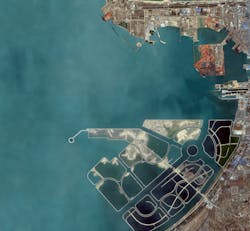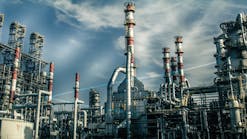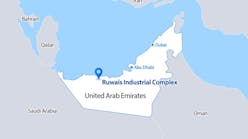Shandong Yulong Petrochemicals lets contract for integrated megacomplex
Nanshan Holdings Co. Ltd.’s majority held Shandong Yulong Petrochemical Co. Ltd. has let a contract to Chevron Lummus Global LLC (CLG)—a joint venture of Chevron Corp.’s Chevron USA Inc. and Lummus Technology LLC—to deliver process technology for a new hydrocracking unit at the operator’s grassroots 20-million tonne/year (tpy) integrated refining and petrochemical complex under construction as part of the Yulong Island Refining and Chemical Integrating Project at Yulong Petrochemical Industrial Park, Yantai City, Shandong Province, China (OGJ Online, Feb. 8, 2021).
Under the contract, CLG, as licensor, will provide technology licensing, engineering, proprietary reactor internals, and catalyst supply for a slurry residue hydrocracking unit equipped with Eni Slurry Technology (EST), CLG said on Dec. 21.
Shandong Yulong Petrochemical will use the new EST hydrocracking unit—which, once operable, will become one of the world’s largest—to convert 3 million tpy of high-sulfur residue into naphtha, diesel, and vacuum gas oil that will provide low-sulfur transportation fuels to the consumer market as well as petrochemical feedstock to downstream units at the Yulong complex, according to the service provider.
CLG revealed neither the value of the contract nor a timeframe for its work on the project.
This latest contract for technology licensing on the project follows Shandong Yulong Petrochemical’s earlier award to CLG’s JV owner Chevron Lummus to deliver licensing of its proprietary CDAlky technology to outfit a new 400,000-tpy alkylation unit that will produce very high-octane, gasoline-blending alkylate to improve fuel efficiency and reduce environmental impacts of finished gasoline product at the complex (OGJ Online, Feb. 18, 2022).
The operator also previously contracted Lummus to license proprietary technologies to be implemented at the complex’s two mixed-feed crackers, an ethylbenzene-styrene monomer (EB-SM) plant, and two polypropylene (PP) plants (OGJ Online, Nov. 17, 2020).
In January 2022, Shaanxi Chemical Construction Engineering Co. Ltd. confirmed it received a nearly 2-billion yuan contract award from Shandong Yulong Petrochemical in late 2021 to deliver engineering and construction on two sections of Phase 1 of the project’s main complex, as well as construction of the refinery’s light hydrocarbon tank farm project.
Since that time, Scientific Design Co. Inc.—jointly owned by Saudi Basic Industries Corp. (SABIC) and Clariant Ltd.—has also confirmed its contract award from Shandong Yulong Petrochemical for licensing of Scientific Design’s proprietary ethylene oxide-ethylene glycol (EO-EG) technology for the complex’s planned 1.02-million tpy monoethylene glycol (MEG) plant, according to an Apr. 8, 2022, from the service provider.
Project progress
While local media out of China have continued reporting other unconfirmed contracts let for work on Phase 1 of the planned complex, Nanshan still has disclosed limited information about the project amid financial constraints in advancing construction of the proposed megacomplex.
In late 2021, Nanshan alongside fellow partners Wanhua Chemical Group Co. Ltd. and China Hualu Group Co. Ltd. jointly entered a capital increase and expansion, or equity restructuring, agreement for Shangdong Yulong Petrochemical with Shandong Energy Group Co. Ltd.—a Shandong provincial government entity—under which Shandong Energy replaced former investor Shandong Development & Investment Holding Group Co. Ltd. to take a 46.1% interest in the project, according to separate notices from Shandong Supervision Office of National Energy Administration and Shandong Energy posted on Nov. 22, 2021.
Under the revised partnership, Nanshan holds a 51% interest in Shandong Yulong Petrochemical, with Wanhua and Hualu holding a combined 2.9% interest in the venture, according to Chinese local media.
With new partners in place and to be fast-tracked in line with China’s ecological priority for a green, low-carbon future, Phase 1 of Shandong Yulong Petrochemical’s planned complex seemingly remains on schedule for startup in June 2023.
Original project design
Budgeted at an investment of nearly 127.4-billion yuan, official project documents from China’s Ministry of Ecology and Environment (MEE) show the Yulong Island Refining and Chemical Integrating Project (Phase 1)—which began construction in late-October 2020—was originally planned to include the following major units and available planned capacities:
- One 10-million tpy atmospheric distillation unit.
- One 10-million tpy combined atmospheric-vacuum distillation unit.
- Two light hydrocarbon recovery units.
- One 2.6-million tpy slurry bed residue hydrogenation unit.
- One 1.2-million tpy solvent deasphalting unit.
- One 100,000-cu m/hr residual oil hydrogen production unit.
- Three 2.6-million tpy residual oil hydrotreating units.
- One 1.5-million tpy wax oil hydrotreating unit.
- One 2-million tpy wax oil hydrocracking unit.
- One 500,000-tpy heavy oil, high-pressure hydrogenation unit.
- One 3.4-million tpy diesel hydrotreating unit.
- One 3.6-million tpy diesel hydrocracking unit.
- One 1.4-million tpy kerosene hydrogenation unit.
- One grassroots hydrogen centralized supply station.
- One 4-million tpy catalytic cracking unit.
- One 1.6-million tpy gas fractionation unit.
- One 1-million tpy pyrolysis gasoline hydrogenation unit.
- One 800,000-tpy aromatic extraction unit.
- One 3-million tpy catalytic cracking unit.
- One 700,000-tpy gas fractionation unit.
- One 1.5-million tpy catalytic gasoline adsorption desulfurization (S-Zorb) unit.
- Two 2.6-million tpy continuous reforming units.
- One 3-million tpy aromatics combined plant.
- One 220,000-cu m/hr coal hydrogen production unit.
- Four 150,000-tpy sulfur recovery and tail gas treatment units.
- One sour water stripping unit.
- One solvent regeneration unit.
- Two 1.5-million tpy ethylene plants.
- Two 85-million tpy pyrolysis gasoline hydrogenation units.
- Two 550,000-tpy aromatics extraction units.
- Two 220,000-tpy butadiene extraction units.
- One 500,000-tpy ethylbenzene-styrene monomer (EB-SM) plant.
- Two 800,000-tpy EG plants.
- Two 400,000-tpy PP plants (Lummus Novolen-licensed).
- Two 400,000-tpy PP plant (separate from Novolen-licensed units).
- One 300,000-tpy PP plant (Japan Polypropylene Corp.-licensed HORIZONE process)
- One 200,000-tpy low-density polyethylene-ethylene vinyl acetate (LDPE-EVA) unit.
- One 400,000-tpy LDPE-EVA unit.
- One 300,000-tpy high-density polyethylene (HDPE) unit.

Robert Brelsford | Downstream Editor
Robert Brelsford joined Oil & Gas Journal in October 2013 as downstream technology editor after 8 years as a crude oil price and news reporter on spot crude transactions at the US Gulf Coast, West Coast, Canadian, and Latin American markets. He holds a BA (2000) in English from Rice University and an MS (2003) in education and social policy from Northwestern University.


